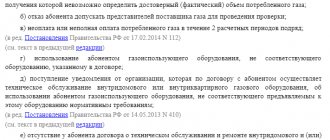Any service provided by housing and communal services must be paid for. If you don’t do this, then they can simply turn it off, and what should you do then? It will be impossible to live. This is especially true for drainage. Limiting water drainage is a real disaster, because it will be impossible to remove water from the sink, bathtub, or toilet. Naturally, using all the plumbing will be much more difficult than if the system was functioning normally.
The problem of non-payment of utility bills by debtors is dealt with strictly. If the user does not heed the warnings, he is given plugs. The legality of restricting water disposal in this case is undeniable. The company has every right to block users from services for which they do not pay. Few people are involved in charity in our country, especially when it comes to the uninterrupted operation of the sewerage system. Maintaining this system is difficult and expensive, and no one likes to work for free.
It works like this:
- Utility service providers demand payment from representatives of management companies;
- They, in turn, “knock out” money from consumers;
- If this cannot be done, a plug is installed, and the company pays the debt, demanding a refund from the user.
Legislation on restriction of water disposal
Any service provided in the housing and communal services sector is subject to mandatory payment. If the user does not pay for the consumed resources for more than 2 months , on the basis of Article 21 of Federal Law No. 416, his access to services will be partially or completely limited. The procedure for blocking the sewer system in the debtor's apartment is a complex and lengthy process.
Restricting water supply consists of several stages:
- resource supplying organizations turn to management companies with claims for non-payment of housing and communal services;
- based on the received application, representatives of the management company address the debtor with a demand for repayment of the debt;
- if funds have not been received into the management company’s account within the established period, a water discharge restriction is imposed on the debtor. To do this, a plug is installed. The debt to the utility service provider is repaid at the expense of the management company’s own funds.
Temporary suspension of sewerage services is recognized as legal if the subscriber does not pay bills for more than 2 months. If the debtor does not agree with the decision, he has the right to appeal it in court.
Notice of drainage restrictions
If a defaulter ignores demands for debt repayment, a blocking device is installed in his home, limiting access to water resources.
Before proceeding with the implementation of this measure, the management company is obliged to send written notifications about the upcoming procedure in 4 copies to the debtor, local authorities, and the territorial unit for sanitary and epidemiological supervision and fire safety. The document indicates the exact amount of the debt and sets out the procedure for temporarily limiting water disposal in case of non-payment.
The notice indicates a specific date when utilities plan to restrict water disposal to debtors. A mandatory requirement is that the subscriber be present at home . If he interferes with the work crew, locks himself in the apartment and does not open the door, the management company has the right to go to court. In some constituent entities of the Russian Federation, there are regional laws that establish an administrative fine for not admitting housing and communal services workers.
Sample notice of water disposal restrictions:
Is it possible to remove the lock yourself?
It is almost impossible for the debtor to remove the block on his own. The fact is that:
- this requires special equipment, which only management companies have (however, other companies, as well as private craftsmen, also have it, but we will talk about this later);
- This requires dismantling the toilet, which is quite problematic.
Therefore, the best way out of the situation is to pay for utilities and not solve the problem yourself.
But if for one reason or another you cannot pay off the debt and apply to the management company for unblocking, then you have only one option left - disconnecting the toilet from the common riser and partially dismantling the common riser.
To do this we need to prepare the following tools:
- durable hook;
- adjustable wrench;
- several wrenches;
- pliers;
- dowels;
- hammer;
- flashlight.
Remember that when you remove the blockage with your own hands, there is a high probability of malfunction of the common riser. Therefore, weigh all the pros and cons, and if the former still outweigh, then proceed.
The process of removing a blockage from a sewer
As noted earlier, in order to remove the plug it is necessary to dismantle the toilet. It will not be possible to skip over this stage, since the blocker is located just after it.
The process of unblocking a sewer includes:
- Shutting off the water.
- Dismantling the drain tank and all communications.
- Unscrewing bolts from the toilet.
- Dismantling the bell. At its base there is a blockage.
- Removal using a rigid hook. The locking device must be hooked and pulled towards you.
In some cases, you can hook the sewer shutoff device using pliers. If the plug is rubber, then a hard hook or pliers will not be needed. Thanks to the elastic walls, you can simply retract it, and you can, as before, fully use the toilet, sink and bathtub.
If the plug is metal and cannot be removed, then carry out an inspection procedure. Tap the pipes. This will show you where the blockage is located. Drill a hole and insert a pin into it. And, hitting it with a hammer, gradually push the device through.
Installation and removal of sewer plugs. Onyx. How it works
But we categorically do not recommend using these methods, since it will still be revealed and in addition to paying off the debt for housing and communal services, at a minimum you will have to compensate the management company for the cost of damaged equipment and the cost of blocking work, and if as a result of unblocking work the riser gets damaged, then you may have to pay a fine for arbitrariness.
Firms and private sewer removal specialists
Removing the blockage from the sewer system without notifying the management company is currently legal, but it is not known what will happen in the future. Therefore, there are companies and private masters who remove the blockage. They have the same equipment as the management company.
Therefore, if you do not want to pay for utilities and are afraid to solve the problem yourself, then seek help from one of these companies or a private master.
Installation of a sewer blocker
Before blocking is carried out, the work team carries out calculation operations that make it possible to establish the exact distance from the point of entry into the riser to the point where the drainage system is turned off. Special cameras are used for this. After receiving the results, the sewer blocker is installed in the calculated hole.
The blocker is pushed into the sewer pipe through the vent, where it blocks the drainage hole. The pipe does not change its geometry, and neighbors in an apartment building do not have problems using the sewer system.
The Federal Law “On Water Supply and Sanitation” determines the right of management companies to block water drainage independently , with the involvement of contractors. Plugs can be made of different materials, so their service life differs. The installation of a blocker should not affect the interests of other owners of living space in a multi-storey building.
The “Rules for the provision of utility services to owners and users of premises” (clause 122) states that the established limitation of water supply should not interfere with living or violate the requirements for the suitability of housing for other residents of an apartment building.
Important! If for some reason the restriction of water supply and sewerage entails a violation of the rights of other owners, the court has the right to impose a ban on the blocking.
How to remove a plug in a sewer and can you do it yourself?
Considering that the consumer-debtor has the right to legally not allow employees of the management organization into his apartment, it is problematic to prove the fact that the plug was removed. The tenant can always claim that he knows nothing about its fate and suggest that it was poorly installed and fell into the riser shaft itself.
There are different methods of how to remove a plug from a sewer yourself, depending on its specific design, the material of manufacture of the riser pipeline, the main ones are:
Universal . Since the damper is located at the outlet of the riser pipe, to which the toilet is connected through a corrugation, the easiest way is to remove the plug from the sewer by dismantling the plumbing fixture. To do this, unscrew the two screws securing the toilet to the floor, close the valve and disconnect the flexible cold water supply from it, after which the device is removed from the toilet room. Next, remove the corrugation and observe the plug itself in the short outlet pipe of the riser.
If a pneumatic model in the form of an inflatable ball is installed, it is pierced with a sharp object and removed by hand. If a cylindrical damper is placed in a riser channel, it is destroyed physically - the metal (polymer) plates are damaged with a steel crowbar or a nail puller, a hole is drilled around the perimeter of the pipe with a long drill using a drill, after which the passage is cleared or the plug falls into the sewer. If there is a mesh, you can cut it with metal scissors or expand the cells with a crowbar for better drainage passage.
Restoring access to sanitation
The Federal Law “On Water Supply and Sanitation” states that if a procedure for terminating or limiting water disposal is introduced in relation to a subscriber, he is obliged to compensate the utility service for the costs of introducing a temporary restriction of access to the service.
Reimbursement is carried out on the basis of the estimated estimate. The document is prepared by the water supply and sewerage organization. The estimate is formed on the basis of documented expenses incurred by the communal structure (clause 4.5 part 1, clause 2-5, 8.9 part 3 of Federal Law-416).
In accordance with the Rules for the Provision of Public Utilities, 2 working days . The specified period will be counted from the moment the application for renewal of the service is delivered to authorized representatives of the management company.
Removing a sewer blocker
The blocker can be legally removed only after the utility debt has been fully repaid. As soon as the debtor has fulfilled his obligations, he must contact the management company with a corresponding request. After checking the information, specialists will visit the site and remove the blocker.
It is not recommended to remove the plug yourself.
This may lead to damage to the drainage system, which will entail the imposition of a fine on the basis of Article 7.7 of the Code of Administrative Offenses of the Russian Federation. Other residents of the apartment building have the right to file a claim against the violator. And also to recover material and moral damages from him.
Arbitrage practice
In some cases, defaulters or public housing estates try to challenge in court the restriction or suspension of water drainage for non-payment of utilities . Let's consider cases when the court satisfies their claims or rejects them.
In the Resolution of the Thirteenth Arbitration Court of Appeal dated January 20, 2015 in case No. A56-19200/2014, the judge ruled in favor of the State Housing Property Inspectorate, which, after an unscheduled inspection, issued an order to the housing cooperative. The GZHI order was based on the fact that the housing cooperative installed additional equipment that was not provided for in the project, the Rules and Standards for Housing Maintenance, the Housing Code of the Russian Federation and clause 1.6 of the Rules and Standards for the Technical Operation of the Housing Stock (Decree of the State Construction Committee No. 170 of September 27, 2003).
The housing cooperative tried to challenge this order of the Housing Housing Inspectorate in court, since many apartment building residents did not pay for utilities for a long time. As a result, the cooperative had to install “plugs” on the debtors’ individual risers and cut off individual apartments from the sewerage system. But the court refused to satisfy the housing cooperative’s demands, basing its decision on the fact that:
- the cooperative had to separately calculate the debt for each type of corporate capital and, before the restriction, notify the debtors, demanding to repay the debt (clause 118 of the RF PP No. 354);
- engineering systems that are part of the common property of the owners of premises in apartment buildings must comply with sanitary and epidemiological safety requirements (clause 9.2 of SanPiN 2.1.2.2645-10).
Thus, the deliberate suspension of water drainage due to the work carried out by housing cooperatives to install “plugs” on individual risers makes the apartment building unsuitable for habitation and does not comply with sanitary and epidemiological safety standards.
However, there is a completely different court decision in a case with a similar plot. Thus, in the Resolution of the Thirteenth Arbitration Court of Appeal dated February 5, 2015 in case No. A56-27564/2014, the judge ruled in favor of the housing cooperative. The court considered that upon prior notification to the debtor of the introduction of special measures in relation to it, the cooperative has the right to limit or suspend water disposal.
The court found, based on the conclusion of the forensic examination center, that the actions of the housing cooperative to install “plugs” to limit water drainage to the engineering systems of the apartment building do not change the parameters of the residential building, do not lead to damage to the debtor’s property and do not violate sanitary and epidemiological safety requirements . Thus, living conditions remained suitable, and the remaining owners of the premises in the house were not affected by the actions of the cooperative.
It is important to note here that the installation of “plugs” to limit water drainage can only be done in those sections of utility lines that do not belong to the common property of the owners of premises in the apartment building. Also, the installation of “plugs” should not lead to damage to the debtor’s personal property.
Read more judicial practice on other cases and issues here
Controversial issues when limiting water disposal
In a number of situations, the debtor can legally achieve the resumption of sewerage services.
Blocking the sewer system is not possible under the following conditions:
- installing a plug on a pipe turns the living space uninhabitable;
- a disabled minor child is registered and permanently resides in the apartment;
- The statute of limitations for claiming the debt has passed (3 years). After the designated time period has passed, the management company will not be able to legally suspend water disposal;
- after installing the plug, the usable area of the apartment is reduced. Therefore, to implement the decision to block the drainage system, the consent of all owners in the house will be required;
- To restrict access to the service, it is necessary to install a blocker and seal the water supply. In the case of sewerage, this is not possible for some multi-storey buildings.
If the court reveals circumstances that violate the rights of the debtor and other homeowners in an apartment building, the decision to suspend sewerage will be declared illegal. In such a situation, the management company will be obliged to resume the service.










